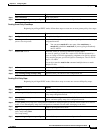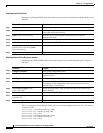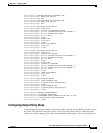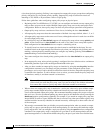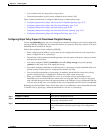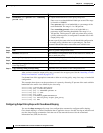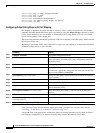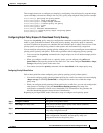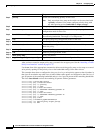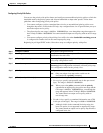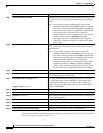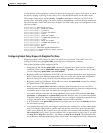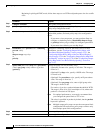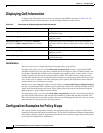
33-57
Cisco ME 3400 Ethernet Access Switch Software Configuration Guide
OL-9639-06
Chapter 33 Configuring QoS
Configuring QoS
This example shows how to configure port shaping by configuring a hierarchical policy map that shapes
a port to 90 Mbps, allocated according to the out-policy policy map configured in the previous example.
Switch(config)# policy-map out-policy-parent
Switch(config-pmap)# class class-default
Switch(config-pmap-c)# shape average 90000000
Switch(config-pmap-c)# service-policy out-policy
Switch(config-pmap-c)# exit
Switch(config-pmap)# exit
Switch(config)# interface fastethernet0/1
Switch(config-if)# service-policy output out-policy-parent
Switch(config-if)# exit
Configuring Output Policy Maps with Class-Based Priority Queuing
You can use the priority policy-map class configuration command to ensure that a particular class of
traffic is given preferential treatment. With strict priority queuing, the priority queue is constantly
serviced; all packets in the queue are scheduled and sent until the queue is empty. Excessive use of the
priority queues can possibly delay packets in other queues and create unnecessary congestion.
You can configure strict priority queuing (priority without police), or you can configure an unconditional
priority policer (priority with police). Follow these guidelines when configuring priority queuing:
• You can associate the priority command with a single unique class for all attached output policies
on the switch.
• When you configure a traffic class as a priority queue, you can configure only police and
queue-limit as other queuing actions for the same class. You cannot configure bandwidth or shape
average with priority queues in the same class.
• You cannot associate the priority command with the class-default of the output policy map.
Configuring Priority Without Police
Follow these guidelines when configuring strict priority queuing (priority without police):
• You cannot configure priority queuing without policing for a traffic class when class-based shaping
(shape average) or CBWFQ (bandwidth) is configured for another class within the output
policy-map.
• When you configure priority queuing without policing for a traffic class, you can only configure the
other queues for sharing by using the bandwidth remaining percent policy-map class
configuration command to allocate excess bandwidth. This command does not guarantee the
allocated bandwidth, but does ensure the rate of distribution.
Beginning in privileged EXEC mode, follow these steps to configure a strict priority queue:
Command Purpose
Step 1
configure terminal Enter global configuration mode.
Step 2
class-map class-map-name Create classes for three egress queues. Enter match conditions
classification for each class.
Step 3
policy-map policy-map-name Create a policy map by entering the policy map name, and enter
policy-map configuration mode.
Step 4
class class-map-name Enter the name of the priority class (created by using the class-map
global configuration command), and enter policy-map class
configuration mode for the priority class.



